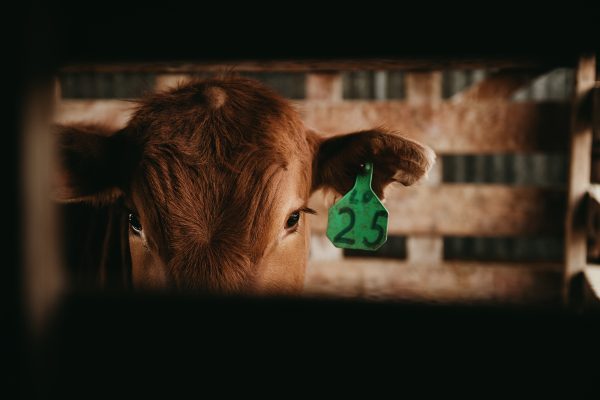
Conjugated Linoleic Acid (CLA)
Conjugated linoleic acid (CLA) is a nutrient found in the fat of ruminant animals that feed on green grass. Researchers are excited about CLA because it is anticarcinogenic at much lower dosages than are many other naturally occurring anticarcinogens. It is effective in laboratory animals at dietary levels as low as 0.05 percent. Grass finished beef has three to five times the amount of CLA as grain fed beef (French et al 2000).
Research suggests CLA may
- Prevent breast cancer especially when present during mammary tissue development (Ip et al 1991; 1994)
- Suppress other cancers (Belury et al 1997a, 1997b; Belury 1995; Cornell et al., 1997; Sugano et al., 1997; Vanden Heuvel etal., 1999)
- Act as an anticarcinogenic at much lower dosages than many other naturally occurring anticarcinogens (Ip et al 1994)
- Inhibit and reduce atherosclerosis (Lee et al 1994; Kritescky 1997; Kritescky et al 2000; Doyle 1998)
- Lower LDL cholesterol and triglyceride levels in the blood (Lee et al 1994; Nicolosi et al 1997; Carew et al., 1987)
- Induce a relative decrease in body fat and increase in lean muscle mass (Doyle, 1998; Park et al 1997; West et al 1998; Cook et al 1997)
- Increase bone health and formation (Doyle 1998)
- Normalize or reduce blood glucose levels, and control and possibly prevent diabetes (Houseknecht et al 1998; Ryder et al. 2001)
- Enhance immune system (Cook et al 1993; Hayek et al 1999)
- Combat allergies and asthma (Cook et al 2000)
(references at bottom of page)
LINKS AND ADDITIONAL READING
Synthetic CLA may fail to supply expected benefits
In a recent study, overweight men were given tablets containing a type of CLA (trans10, cis12 CLA) found in significant quantities in most commercial supplements. The supplements lowered the men’s “good” HDL cholesterol, raised their blood sugar, and made them more resistant to insulin—changes that are linked with a greater risk of diabetes, obesity and heart problems. These health problems are not associated with the natural CLA found in meat and dairy products.
(Riserus, U. et al. 2002. Treatment with dietary trans10cis12 conjugated linoleic acid causes isomer-specific insulin resistance in obese men with the metabolic syndrome Diabetes Care 25: 1516-21.)
CLA is found naturally in a variety of ruminant meats (French, et al, 2000) and dairy products (Dhiman, et al, 1999), due to the anaerobic activity of the rumen bacterium Butyrivibrio fibrisolvens. This rumen organism is responsible for the biohydrogenation of linoleic and linolenic acids into the conjugated isomers referred to as CLA. Because linoleic and linolenic acid is a precursor, diets rich in these compounds increase the concentration of the CLA within the fat depot of the animal. Lush green forages are high in this precursor, therefore, grass-fed ruminant species have been shown to produce 2 to 3 times more CLA than ruminants fed in confinement on concentrate-only diets (French, et al, 2000; Duckett, et al, 1993; Rule, et al, 2002; Mandell et al, 1998).
REFERENCES
Belury, M.A. 1995. Conjugated dienoic linoleate: a polyunsaturated fatty acid with unique hemoprotective properties. Nutr. Rev. 53:83-89:1995.
Belury, M.A., and J.P. Vanden Heuvel. 1997b. Protection against cancer and heart disease by the dietary fat, conjugated linoleic acid: potential mechanisms of action. Nutr. Dis. Update J. 1:59-63.
Belury, M.A., S.Y. Moya-Camarena, K.L. Liu, and J.P. Vanden Heuvel. 1997a. Dietary conjugated linoleic acid induces peroxisome-specific enzyme accumulation and ornithine decarboxylase activity in mouse liver. J. Nutr. Biochem. 8:579-584.
Bougnoux P., F. Lavillonniere, E. Riboli et al. 1999. Inverse relationship between CLA in dipose breast tissue and risk of breast cancer: A case-control study in France. Am. Oil Chemist’s Soc. Annual meeting Abstr. Health and Nutrition Section-3, S43.
Carew, T.E., D.C. Schwenke, and D. Steinberg. 1987. Antiatherogenic effect of probucol unrelated to its hypocholesterolemic effect: Evidence that antioxidants in vivo can selectively inhibit low density lipoprotein degradation in macrophage-rich fatty straks and slow the progression of atherosclerosis in the Watanabe heritable hyperlipidemic rabbit. Proc. Natl. Acad. Sci. USA 84:7725-7729.
Cook, M.E., C.C. Miller, Y. Park, and M.W. Pariza. 1993. Immune modulation by altered nutrient metabolism: nutritional control of immune-induced growth depression. Poultry Sci. 72:1301-1305.
Cook, M.E., L.E. Whigham, M. Yang, D. Devoney, and M.W Pariza. 2000. Regulation of inducible prostranoids and leukotrienes by conjugated linoleic acid (CLA). Am. Chem. Soc. 220th Nat Meeting. Aug 20-24. Abstract AGFD-10.
Cook, M.E.; Jerome, D.L.; Buege, D.R.; Russell, R.L.; Crenshaw, T.C.; Storkson, J.; Albright, K.; Liu, W.; Park, Y.; Pariza, M.W.; Scimeca, J.A.; Lofgren, P.; Hentges, E. 1997. Conjugated linoleic acid (CLA) reduces backfat thickness, increases percent lean and improves feed efficiency in pigs. Food Research Institute, Univ. Wisconsin, 1997 Annual Mtg. (poster abstr.).
Cornell, K.K., D.J. Waters, K.T. Coffman, J.P. Robinson, and B.A. Watkins. 1997. Conjugated linoleic acid inhibited the in vitro proliferation of canine prostate cancer cells. FASEB J. 11:A579.
Dhiman, T.R. 2000. Conjugated linoleic acid: A food for cancer prevention. Feedstuffs Special Report, May 1, 2000.
Dhiman, T.R., G.R. Anand, et al. 1999. Conjugated linoleic acid content of milk from cows fed different diets. J Dairy Sci 82(10):21 46-56.
Doyle, E. 1998. Scientific forum explores CLA knowledge. INFORM 9(1):69-73.
French, P., Stanton, C., Lawless, F., O’Riordan, E.G., Monahan, F.J., Caffrey, P.J. and A.P. Moloney. (2000) Fatty acid composition, including cis-9, trans-11 octadecanoic acid, of intramuscular fat from steers offered grazed grass, grass silage or concentrates. Journal of Animal Science 78, 2849-2855.
Ha, Y.L., J. Storkson and M.W. Pariza. 1990. Inhibition of benzo(a)pyrene-induced mouse forestomach neoplasia by conjugated dienoic derivatives of linoleic acid. Cancer Res. 50:1097.
Ha, Y.L., N.K. Grimm and M.W. Pariza. 1987. Anticarcinogens from fried ground beef: Heat-altered derivatives of linoleic acid. Carcinogenesis 8:1881.
Hayek, M.G., S.N. Han, D.Y. Wu, B.A. Watkins, M Meydani, J.L. Dorsey, D.E. Smith, and S.N. Meydani. 1999. Dietary conjugated linoleic acid influences the immune response of young and old C57BL/6NCrlBR mice. J. Nutr. 129:32-38
Houseknecht, K.L., J.P. Vanden Heuvel, S.Y. Moya-camarena et al. 1998. Dietary conjugated linoleci acid normalizes impaired glucose tolerance in the Zucker diabetic fatty fa/fa rat. Biochemical Biophy. Res. Comm. 244:678.
Ip, C., S. Banni, E. Angioni et al. 1999. Conjugated linoleic acid-enriched butter fat alters mammary bland morphogenesis and reduces cancer risk in rats. J. Nutr. 129:2135.
Ip, C., S.F. Chin, J.A. Scimeca and M.W. Pariza. 1991. Mammary cancer prevention by conjugated dienoic derivative of linoleic acid. Cancer Res. 51:6118.
Ip, C.; Singh, M.; Thompson, H.J.; Scimeca, J.A. 1994. Conjugated linoleic acid suppresses mammary carcinogenesis and proliferative activity of the mammary gland in the rat. Cancer Res. 54:1212-1215.
Knekt, P., R. Jarvinen, R. Seppanen et al. 1996. Intake of dairy products and the risk of breast cancer. Br. J. Cancer. 73:687.
Kritchevsky, D. 1997. Conjugated linoleic acid and experimental atherosclerosis in rabbits. In Advances in Conjugated Linoleic Acid Research. M.P. Yurawecz, M.M. Mossoba, J.K.G. Kramer, M.W. Pariza, and G.J. Nelson (eds), AOCS Press. Champaign, IL, Vol. 1. p397-403.
Kritchevsky, D., S.A. Tepper, S. Wright, P. Tso, and S.K. Czarnecki. 2000. Influence of conjugated linoleic acid (CLA) on establishment and progression of athersoclerosis in rabbits. J. Am. Coll. Nutr. 19:472S-477S.
Lee, K.N., D. Kritchevsky and M.W. Pariza. 1994. Conjugated linoleic acid and atherosclerosis in rabbits. Atherosclerosis 108:19.
Nicolosi, R.J., E.J. Rogers, D. Kritchevsky, J.A. Scimeca, and P.J. Huth. 1997. Dietary conjugated linoleic acid reduces plasma lipoproteins and early aortic atherosclerosis in hypercholesterolemic hamsters. Artery 22:266-277.
Park, Y., K.J. Albright, W. Liu et al. 1997. Effect of conjugated linoleic acid on body composition in mice. Lipids 34:235.
Peck, C. 2000. Paving the way for CLA. Beef Producer Robinson, J. 2000. Why Grassfed is Best! The Surprising Benefits of Grassfed Meat, Eggs, and Dairy Products. Vashon, WA, Vashon Island Press.
Ryder, J.W., C.P. Portocarrero, X.M. Song, L. Cui, M. Yu, T. Combatsiaris, D. Galuska, D.E. Bauman, D.M. Barbano, M.J. Charron, J.R. Zierath, and K.L. Houseknecht. 2001. Isomer specific antidiabetic properties of conjugated linoleic acid: Improved glucose tolerance, skeletal muscle insulin action, and UCP-2 gene expression. Diabetes 50:1149-1157.
Sugano, M., A. Tsujita, M. Yamasaki, K. Yamada, I. Ikeda, and D. Kritchevsky. 1997. Lymphatic recovery, tissue disruption, and metabolic effects of conjugated linoleic acid in rats. J. Nutr. Biochem. 8:38-43.
Vanden Heuvel, J.P. 1999. Peroxisome proliferator-activated receptors: A critical link among fatty acids, gene expression and carcinogenesis. J. Nutr. 129(suppl.):575S-580S.
West, D.B.; Delany, J.P.; Camet, P.M.;Blohm, F.; Truett, A.A.; Scimeca, J. 1998. Effects of conjugated linoleic acid on body fat and energy metabolism in the mouse. Am. J. Physiol. 44:R667-R672.







Leave a Reply